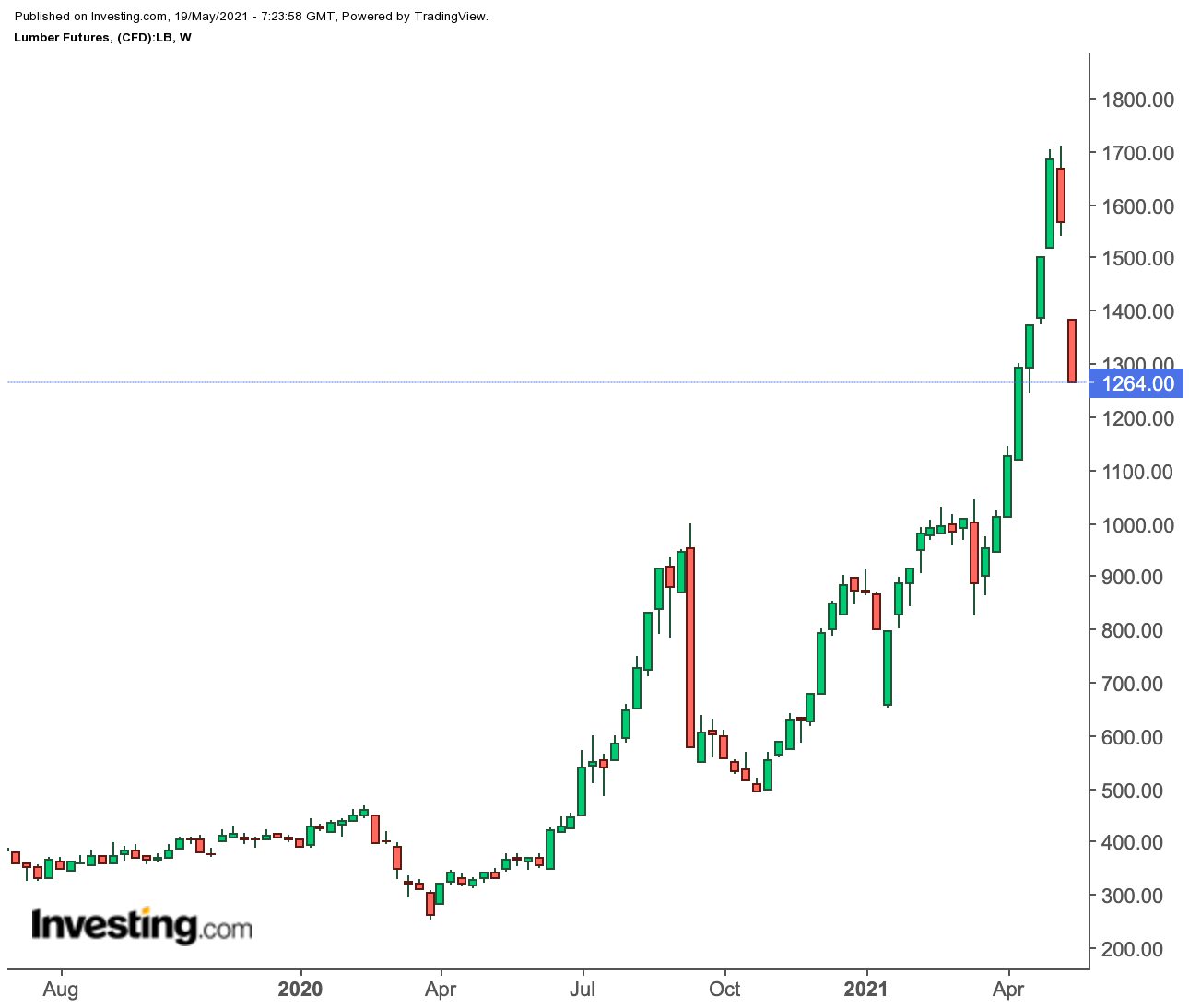Something had to give—the high prices of houses or the lumber that goes into building them.
For now, it appears it will be the wood, as home builders pulled back sharply on construction in April in a bid to avoid loading up on lumber which has rallied more than 300% this year.

The move, coming despite relentless demand from home buyers, triggered a third straight day of losses in lumber that proved to be the market’s worst in eight months.
At Tuesday’s settlement, US lumber futures for July delivery per board footage settled at $1,264 per board foot, down almost 5% on the day.
The slump followed data from the Commerce Department that showed US housing starts down almost 10% in April due to a pullback in activity from builders probably reacting to soaring prices of most materials, including lumber.
Even prior to Tuesday, lumber prices had been falling, giving back 15% on Monday and nearly 4% on Friday.
Combined, the drop of $366, or nearly 23%, over the three days since Thursday’s last positive close of $1,630 marked the sharpest loss for lumber since the Sept. 15-17 period.
During those three days of September, the market lost $387, or 42%. At that time though, lumber was trading below $1,000 per ft board. This year alone, it has traded as high as $1,711, weighing considerably on the bottomline of builders.
Industry experts have been warning that there’s a limit to the rise in materials prices that builders can take, or the floor might just cave.
Is This The Start Of A More Meaningful Correction In Lumber?
What we have seen over the past three trading sessions in US lumber may just be the start of a more meaningful correction, if Paul Jannke -- a timber markets specialist who predicted the slump in a mid-March forecast -- is right.
Jannke of Forest Economic Advisors has spent 25 years studying timber markets. He traced the start of this year's lumber rally to the collapse of log harvesting and milling between March and May 2020, at the outset of the COVID outbreak in North America.
"We see prices plunging in May/June to around $800," Jannke had said. "We expect that to occur as dealers take a step back."
"Prices are extremely high, so dealers are nervous about buying any more wood at these high price levels. So, we do expect to see a bit of a crack in these high lumber prices."
Jannke said prices were also expected to come off on the easing of transportation disruptions and other bottlenecks in logistics and supply that should set the stage for further consolidation.
"As soon as prices again get down into the $700-$800 range, we expect dealers are going to step back in and buy. That should cause a rebound with prices bounding back into the $900s.
"In the second half of this year and next year, we do expect prices to come off dramatically as supply comes back in full force."
Housing Starts Tell The Story Of Builder Hesitation
That lumber prices have begun to contract exactly as Jannke predicted shouldn’t surprise anyone who’s been paying attention to the details in the monthly housing starts put out by the Commerce Department.
The department said on Tuesday that the number of houses authorized for construction, but which have not yet started construction, are at the highest levels since 1999, suggesting hesitancy on the part of builders.
Mike Fratantoni, chief economist at the Mortgage Bankers Association in Washington, said builders were undoubtedly delaying starting new construction because of the marked increase in costs for lumber and other inputs.
Added Fratantoni, in a quote carried by Reuters:
"These supply-chain constraints are holding back a housing market that should otherwise be picking up speed, given the strong demand for buying fueled by an improving job market and low mortgage rates."
The housing market—the epitome of the so-called American Dream—is one of the pillars of the US economy, accounting for nearly 15 percent of Gross Domestic Product.
Housing has been the star performer in the economy's recovery from the COVID-19 recession, which started in February 2020. Residential construction investment has enjoyed double-digit growth since the third quarter of last year.
A US lumber shortage has caused prices to more than triple within the last year and add thousands to the overall costs of new home construction in the country.
In just one year, the price of lumber has increased about 370%—reaching a record high above $1,700 per 1,000 bd ft. For context, lumber has historically fluctuated between $200 to $400.
Across the United States, the average price for a single home shot up by $35,872, according to an analysis conducted last week by the National Association of Home Builders.
In a recent survey in Nevada published by the Las Vegas Review-Journal, new single-family homes, on average, can cost $25,000 more, and for larger homes, the lumber shortage could cost upward of $50,000 to $60,000 more.
Despite the slump in lumber futures over the past three days, physical prices of lumber have not moved to the downside.
According to the latest analysis by Random Lengths, the industry’s tracking firm, the price of framing lumber was at $1,327 per thousand board feet on Tuesday—up from $1,200 on Apr. 23.
Disclaimer: Barani Krishnan uses a range of views outside his own to bring diversity to his analysis of any market. For neutrality, he sometimes presents contrarian views and market variables. He does not hold a position in the commodities and securities he writes about.
